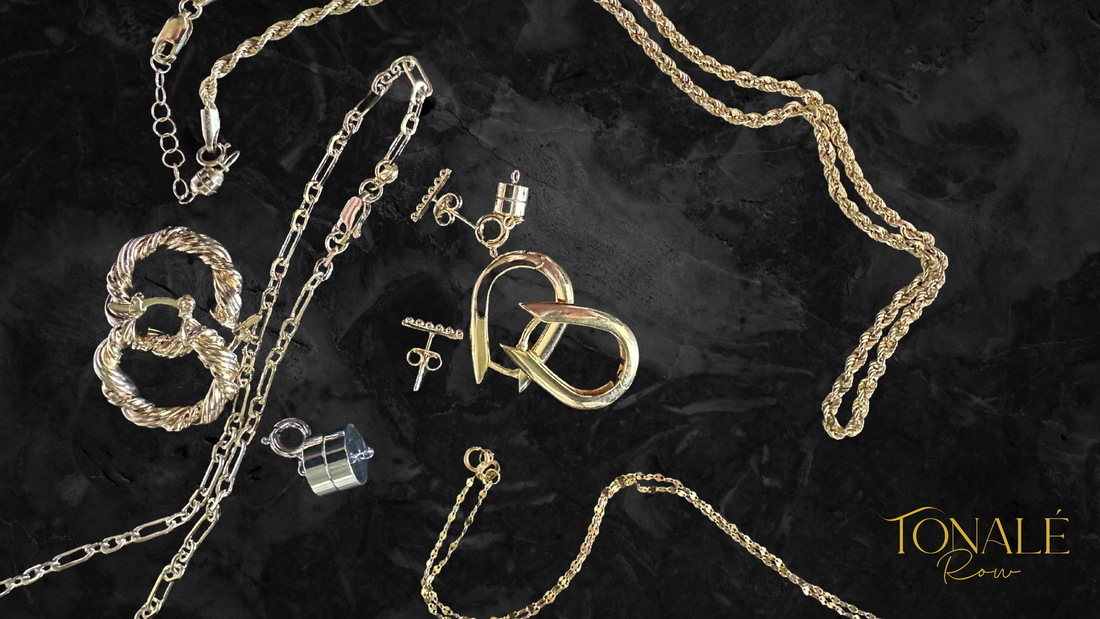
Jewelry Mechanisms 101: Understanding Clasps, Closures & Earring Backings
Whether you’re shopping with Tonalé Row or anywhere else online, knowing your jewelry terminology helps you make confident choices. From earring backings to necklace and bracelet clasps, each mechanism has its own purpose, security level, and style. This guide breaks it down simply so you can shop smarter — and enjoy your pieces longer.
Earring Styles & Backings
| Type | How It Works | Best For | Pros | Cons |
|---|---|---|---|---|
| Shepherd Hooks (Fish Hooks) | Curved wire threads through the ear | Dangles & lightweight earrings | Easy to wear, classic look | Can slip without stoppers |
| Clicker Hoops | Hinged hoop snaps shut with a “click” | Everyday hoops & huggies | Secure, sleek, comfortable | Hinge can loosen with heavy use |
| Leverbacks | Hook closes with a hinged lever | Drop earrings, more formal wear | Very secure, elegant style | Slightly bulkier than hooks |
| Push Backs (Butterfly/Clutch) | Post with a butterfly clutch slides on | Everyday studs | Simple, widely available | Can loosen over time |
| Screw Backs | Back twists onto threaded post | Fine jewelry, kids’ studs | Very secure, long wear | Trickier to put on/take off |
| Latch Backs | Post snaps into groove behind ear | Hoops, huggies | Reliable, easy to fasten | Can pinch if misaligned |
| Saddlebacks | Post fits into a hinged arm that locks into a saddle-shaped latch | Medium to large hoops | Secure, easy to operate, comfortable | Hinge can weaken over time |
Bracelet & Necklace Clasps
| Type | How It Works | Best For | Pros | Cons |
|---|---|---|---|---|
| Lobster Clasp | Spring-loaded arm opens & closes | Heavier chains, daily wear | Strong, reliable | Small size can be tricky to fasten |
| Spring Ring Clasp | Spring-loaded circular trigger | Lightweight chains | Common, low profile | Less secure for heavy jewelry |
| T-Bar / Toggle Clasp | Bar slides through ring | Statement pieces, layered necklaces | Easy to fasten, decorative | Less secure for fine or heavy chains |
| Box Clasp | Flat tab clicks into box with latch | Tennis bracelets, fine necklaces | Very secure, often decorative | More expensive setting |
| Magnetic Clasp | Magnets snap together | Necklaces, lightweight chains | Convenient, quick on/off | Not ideal for heavy pieces |
Spotlight: Magnetic Clasp Converters
At Tonalé Row, we’re introducing magnetic clasp converters — add-ons that turn many necklaces into easy-on, easy-off pieces. They’re especially helpful if you have long nails, dexterity issues, or simply want faster fastening.
- Match magnet strength to chain weight: light magnets for dainty chains; stronger magnets for medium-weight chains.
- Necklace-first recommendation: better for necklaces than bracelets, since wrists are more likely to contact magnetic surfaces.
- Check compatibility: inspect jump rings on fine/vintage chains before attaching.
- Safety note: magnets can interfere with certain medical devices. If you use a pacemaker or similar device, consult your clinician before wearing magnetic jewelry and keep magnets at a safe distance.
How to Choose the Right Mechanism
- Security: Daily wear or valuable stones often benefit from screw backs (studs) or lobster/box clasps (chains).
- Ease of Use: If small clasps are frustrating, magnetic converters or toggles are great options (size appropriately).
- Style: Visible closures (toggles, box clasps) add design interest; others are more discreet.
Final Thoughts
The right closure or backing isn’t just about security — it’s also about comfort and style. By understanding how each mechanism works, you’ll shop online with more confidence and keep your jewelry secure for years to come.
